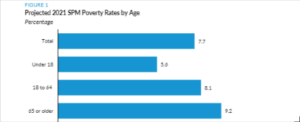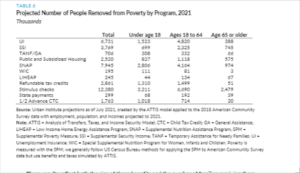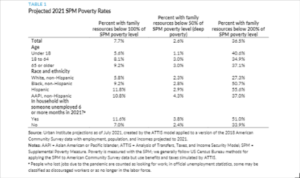Marty Levine
8/4/2021
Last week I questioned whether private philanthropy was able to handle the pressing societal challenges we face. A study commissioned by the Urban Institute that was published as July ended can shed some new light on this question.
Laura Wheaton, Linda Giannarelli, and Ilham Dehry, the researchers responsible for “2021 Poverty Projections: Assessing the Impact of Benefits and Stimulus Measures “ set out to measure the impact of the dramatic investments that Federal and state governments have made to combat the negative economic impact of the ongoing pandemic. Their findings tell us that these investments made a dramatic positive impact on millions of lives and that only governments could undertake an effort of this scope and size.
Their findings are of particular interest in a moment when much of the special assistance that comprised the several rounds of emergency assistance is coming to an end and when Congress and the President are in active debate of what should come next.
Beginning in March 2020, the Federal Government began to invest heavily in programs designed to shore up and expand the economic safety net that could protect American households from the economic toll of COVID-19. Specifically, funding for new and expanded funding was distributed through existing and new programs:
Traditional Unemployment Insurance (UI) and traditional means-tested programs
◼ Unemployment Insurance (UI) (including policy expansions)
◼ Supplemental Security Income (SSI)
◼ Temporary Assistance for Needy Families (TANF) and Solely State Funded Benefits
◼ Public and subsidized housing
◼ Supplemental Nutrition Assistance Program (SNAP) (including policy expansions)
◼ Special Supplemental Nutrition Program for Women, Infants and Children (WIC) (including policy expansions)
◼ Low Income Home Energy Assistance Program (including policy expansions)
◼ Earned income tax credit and additional child tax credit (at traditional levels)
New cash payments
◼ Second stimulus check (December 2020 legislation)
◼ Retroactive CARES stimulus check for certain families with mixed immigration statuses
◼ Third stimulus check (American Rescue Plan)
◼ One-half of the advance child tax credit
◼ State pandemic relief payments (six states)
◼ State “back to work” bonuses (seven states)
According to the data collected the size of these investments was unprecedented. “We project that total UI benefits and means-tested benefits reflected in these estimates will increase from $237 billion in 2018 to $508 billion in 2021 and that families will receive $549 billion in stimulus payments, state payments, and advance child tax credit payments in 2021.” Looking at how the specific impact on poor households the authors projected “that the total UI and means tested benefits paid to families who have income below the SPM poverty threshold before counting UI, means-tested benefits, federal stimulus payments, state payments, and the advance child tax credit will increase from $161 billion in 2018 to $302 billion in 2021, and that these families will receive $150 billion in federal stimulus payments, state payments, and advance child tax credit payments.”

Using the Census Bureau’s Supplemental Poverty Measure (SPM) as their yardstick, a measure that factors in a broad range of cash and non-cash supports along with living expenses, the study found that there has been a dramatic reduction in poverty rates because of these programs. With the benefits provided across the nation “the annual poverty rate projection for 2021, 7.7 percent, is well below the rate of 13.9 percent that we estimate for 2018 with the same methods. The projected percentage of people in deep poverty in 2021 (that is, with family income less than half the poverty threshold) is 2.6 percent, compared with 4.2 percent in 2018.”

The programs did not wipe away the built-in systemic bias of our economy. Black and Hispanic households continue to lag. “The projected percentage of white, non-Hispanic people in poverty (5.8 percent) is lower than for Black, non-Hispanic people (9.2 percent), AAPIs (10.8 percent), and Hispanic people (11.8 percent). Black and Hispanic people were more likely than white, non-Hispanic people to lose their jobs during the pandemic. The higher projected poverty rates of Black and Hispanic people relative to white non-Hispanic people also reflect historical disparities among these groups…”

All in all, the researchers concluded that Government programs can make a real difference. “Our projections demonstrate that government benefits can reduce poverty well below traditional levels when substantial resources are devoted to that task. Policymakers who want to make some aspects of the higher level of support permanent will need to consider the appropriate levels and types of increased supports, the best ways to fund such efforts, and the potential macroeconomic implications of various choices…”
Their cost is large, well beyond even the wealthiest socially conscious philanthropist’s capability.
The human impact is even greater.
It is time to stop debating whether we can ever end poverty. We can if we choose to act.
Before us is a moral question, not one about our capabilities.
Do we care enough about the value of each life in our nation to make the difference we know we can make?
All the other issues that are raised to question building a government safety net that is strong and sufficient are just deflections. Yes, there will be some inefficiencies in the system. Yes, some people may cheat. Yes, some who do not need the help may get it. But these are issues on the fringe and not real reasons to turn away from t we must do.
Yes, each of us can donate to worthy causes but this too is a deflection. It makes us feel good but cannot replace a government-created, universal safety net.
We need to look ourselves directly in the mirror and know that this is about our care, concern, and commitment to each other. This is about acting on what we can do that will make a difference and being willing to make the sacrifices that it will take.

Your piece makes it pretty clear, Marty, that we can erase poverty. What lifts one, lifts us all. Thanks!